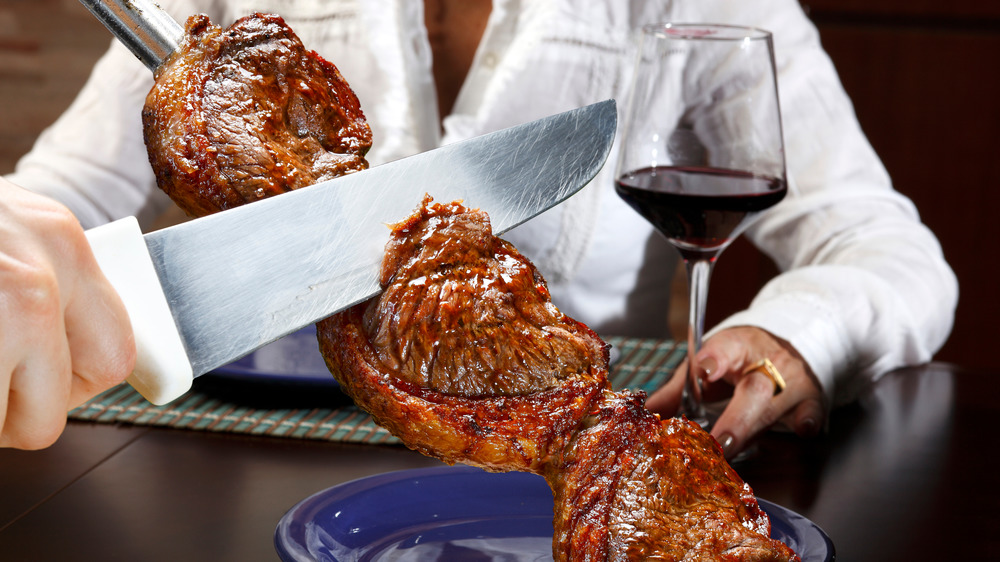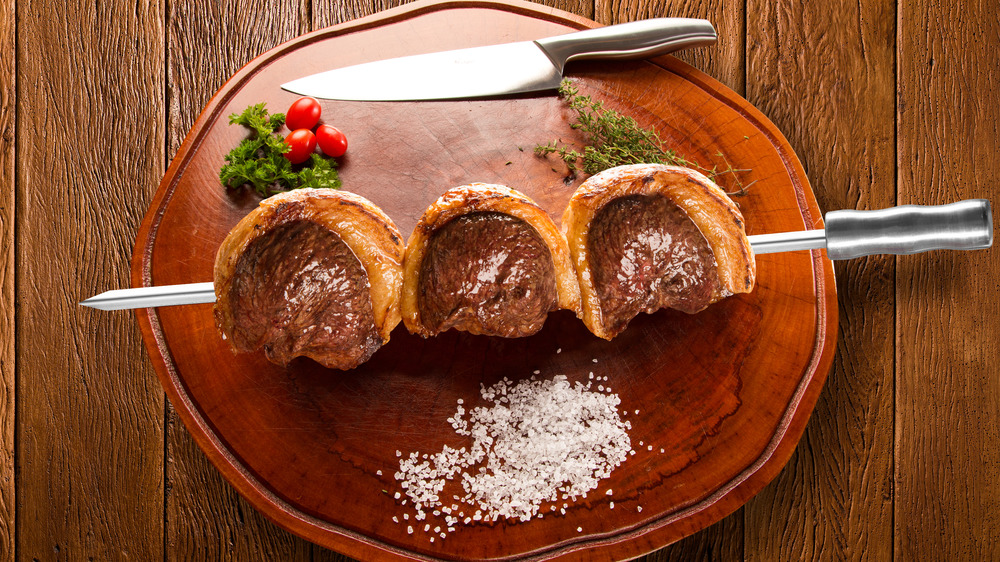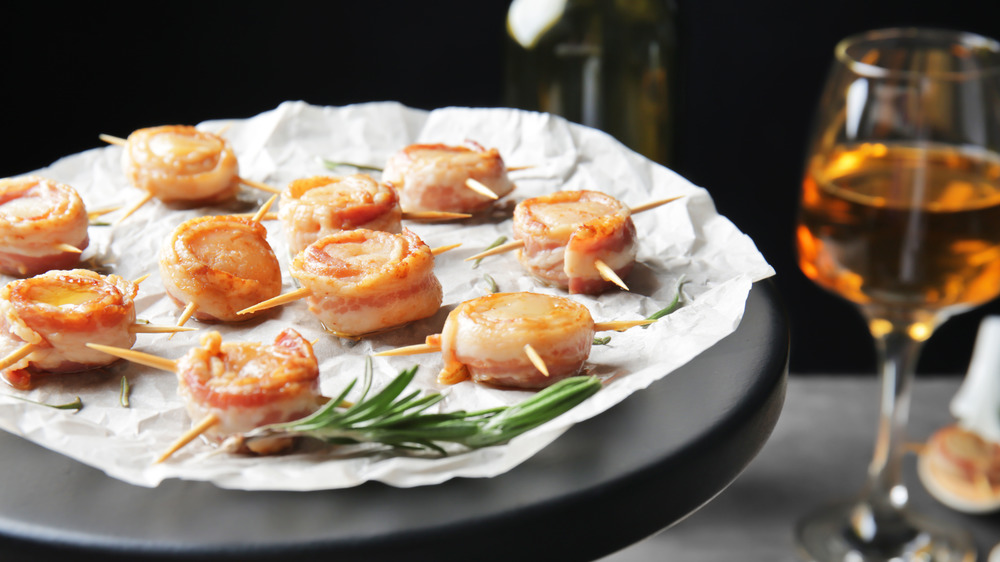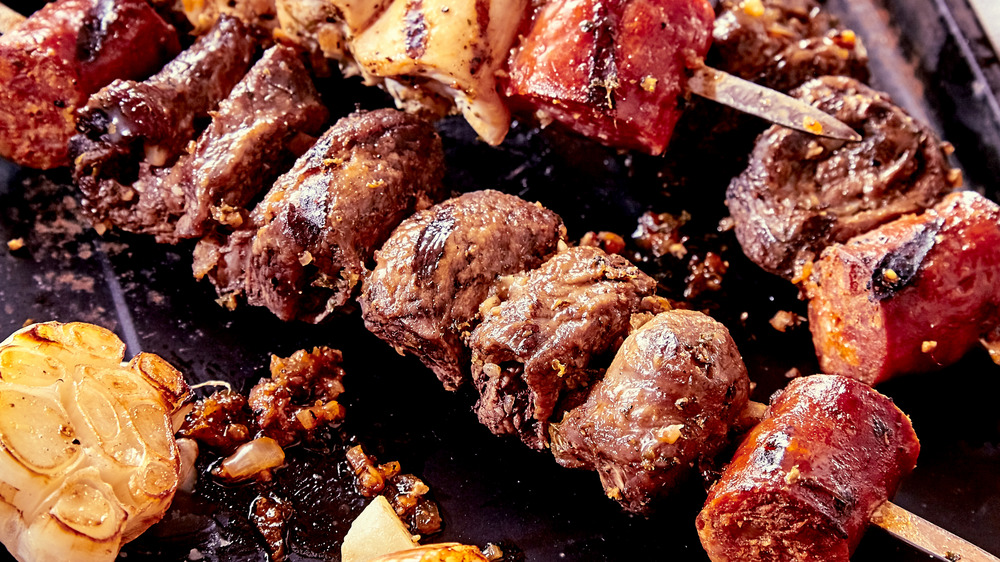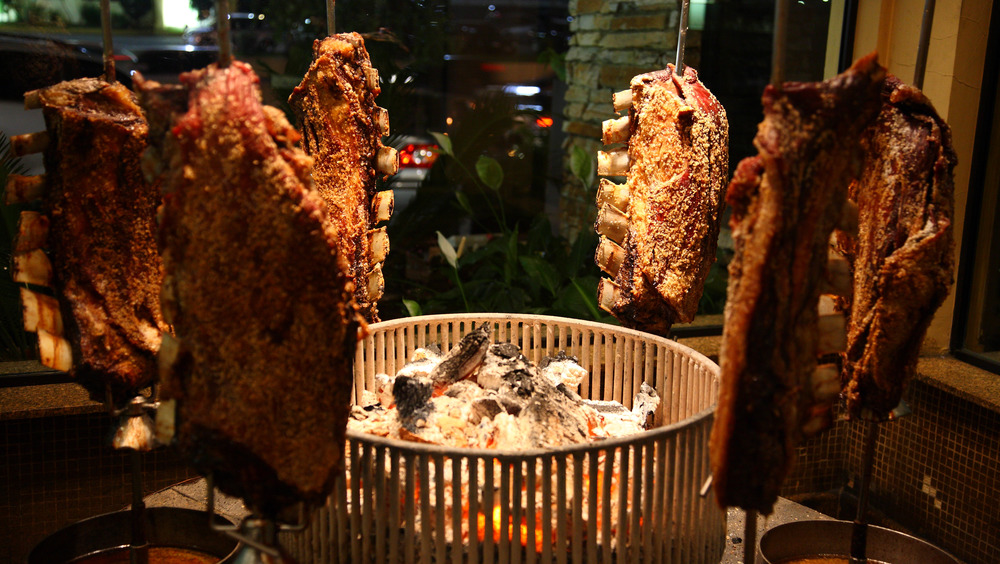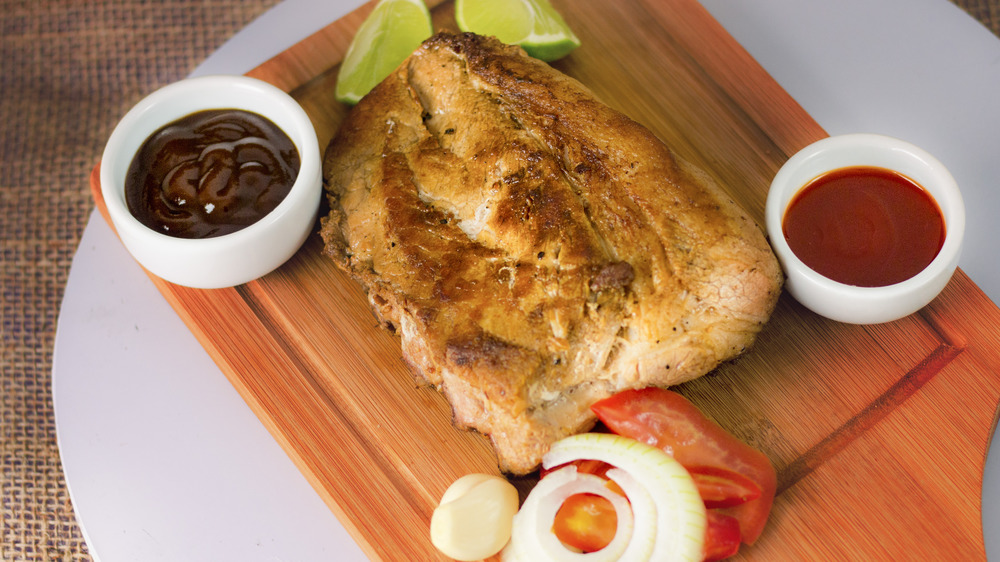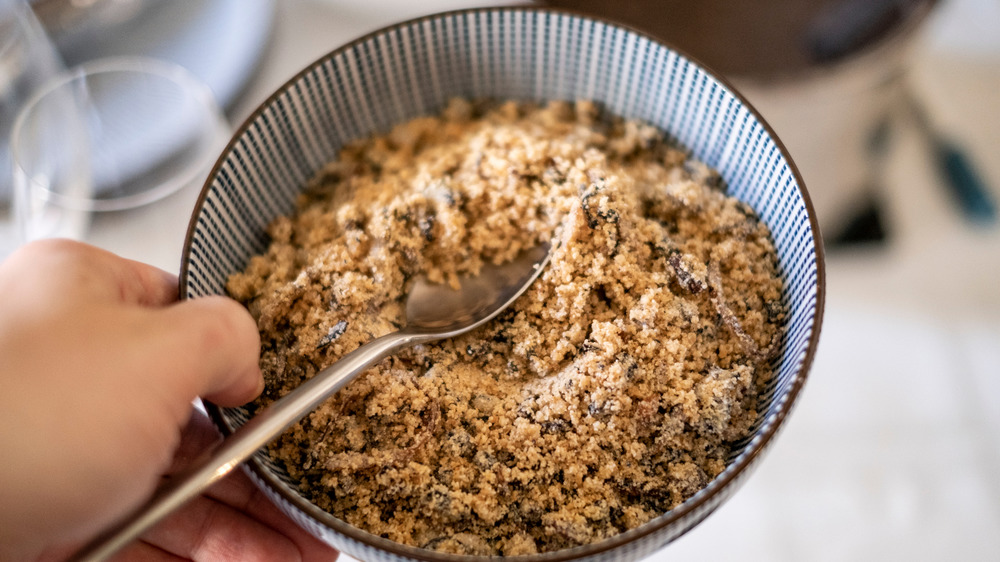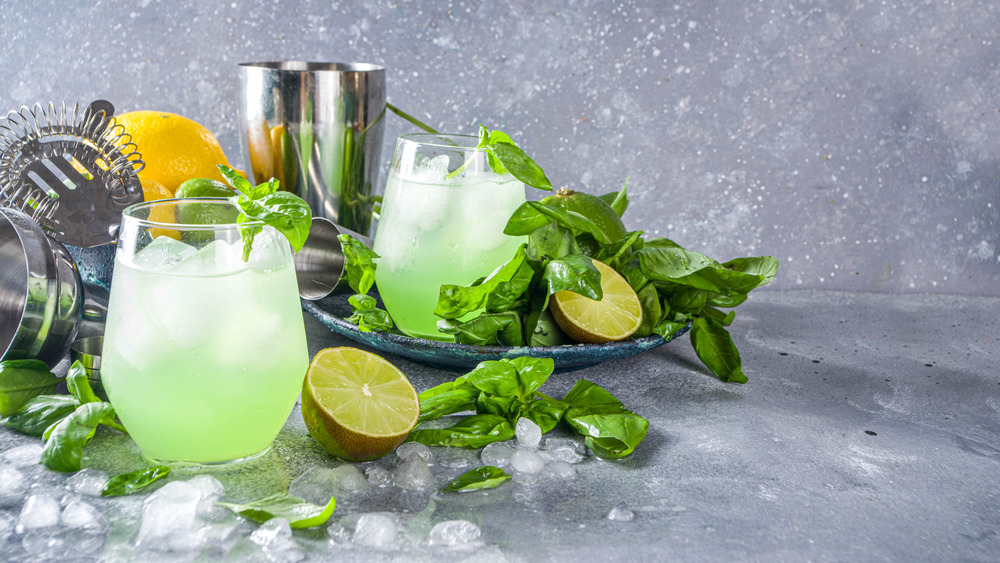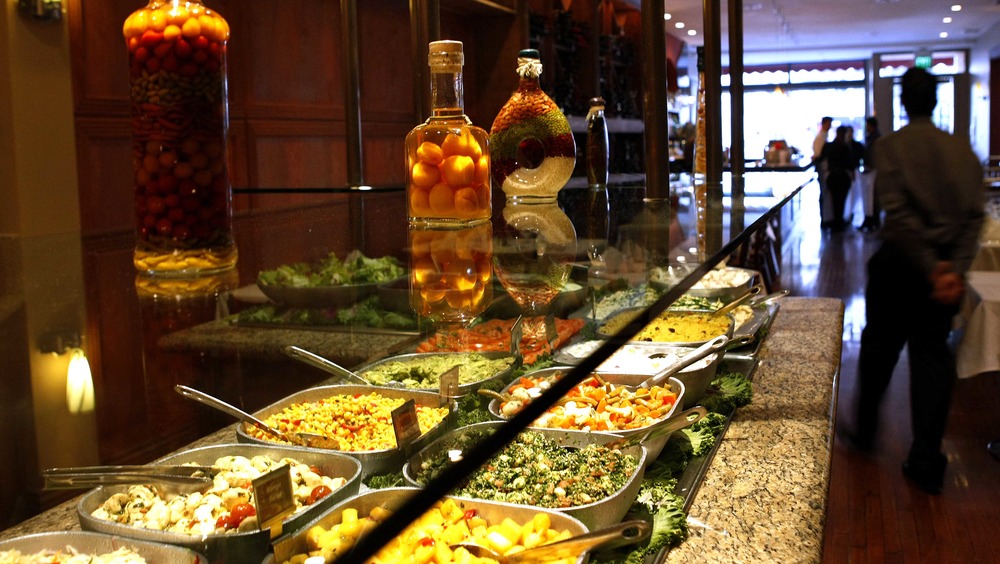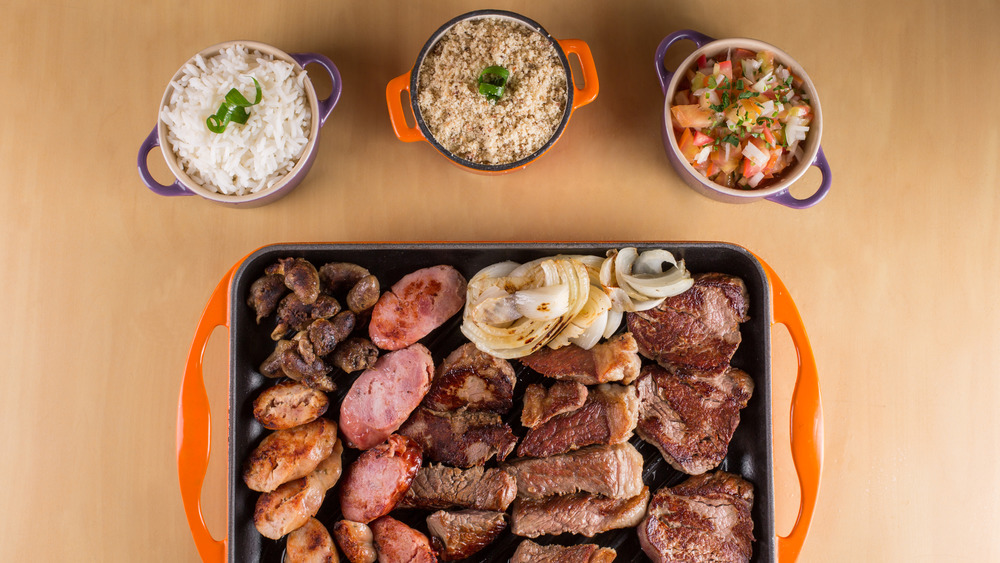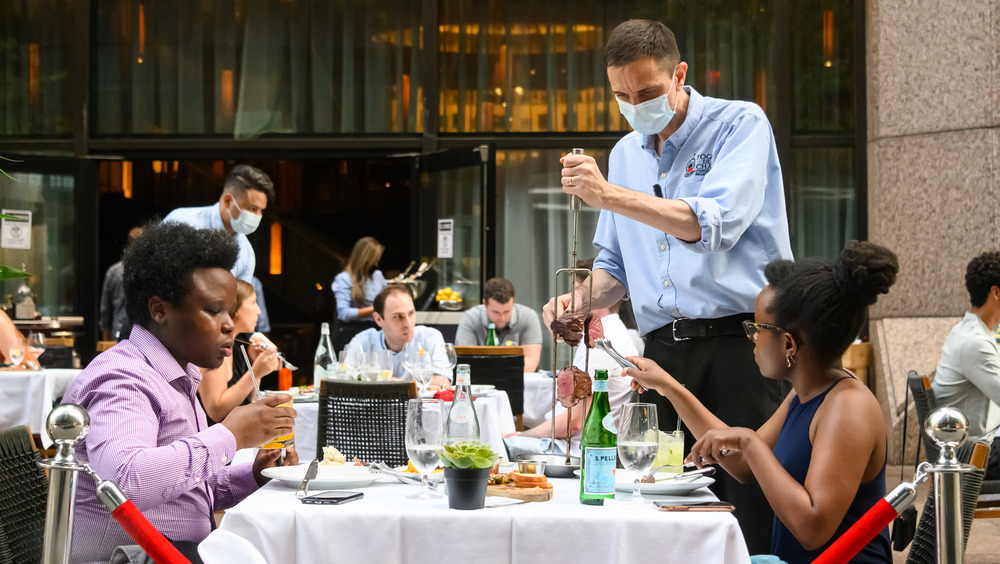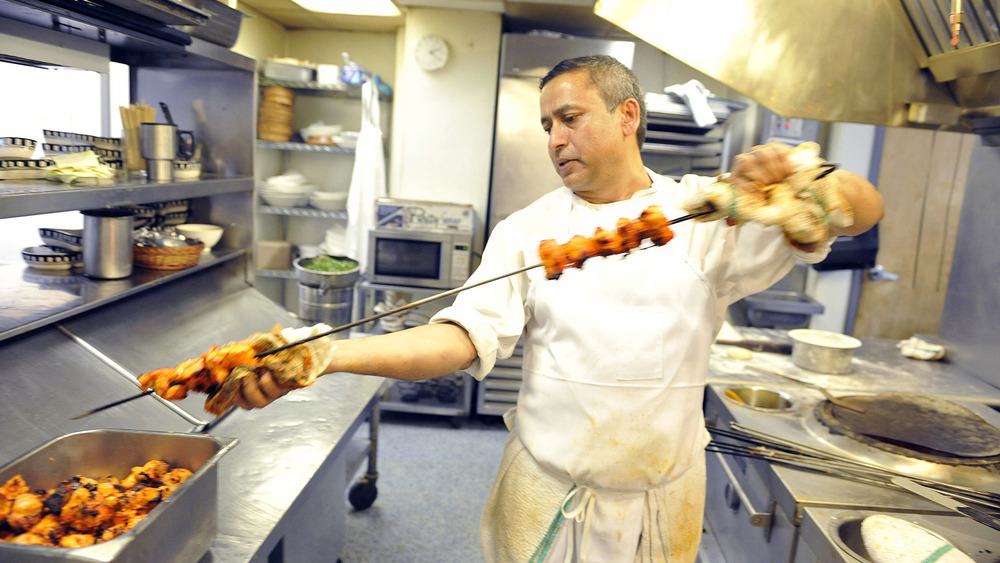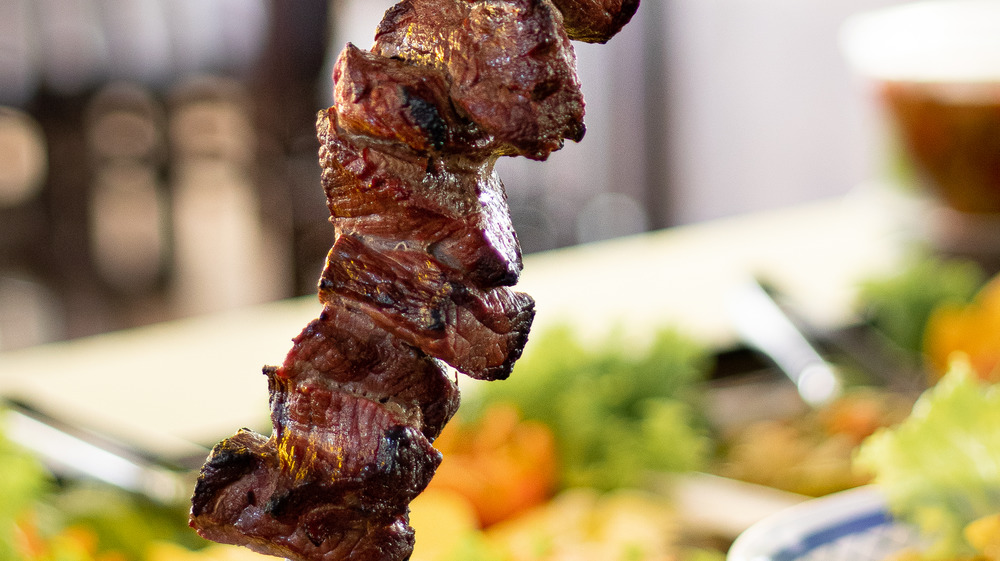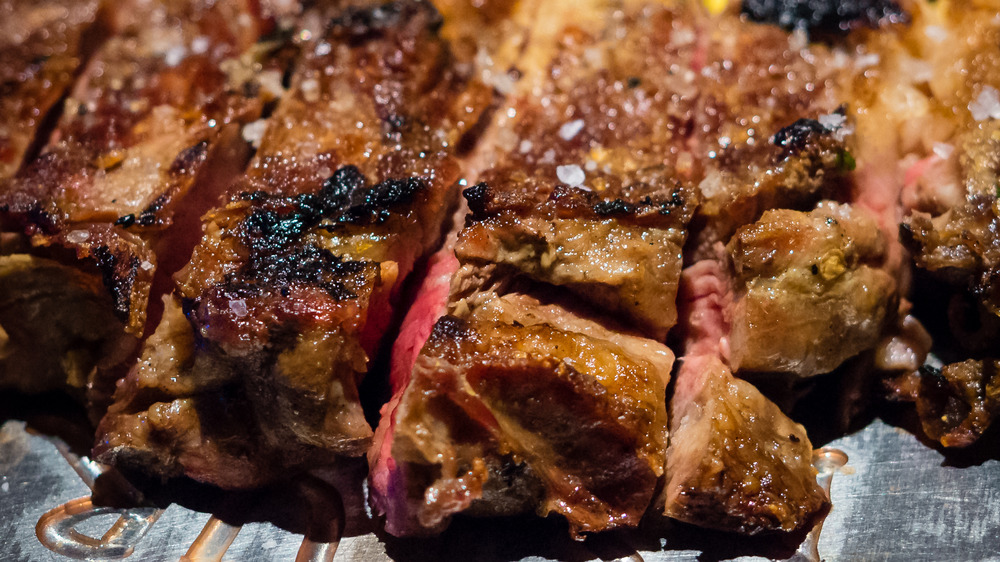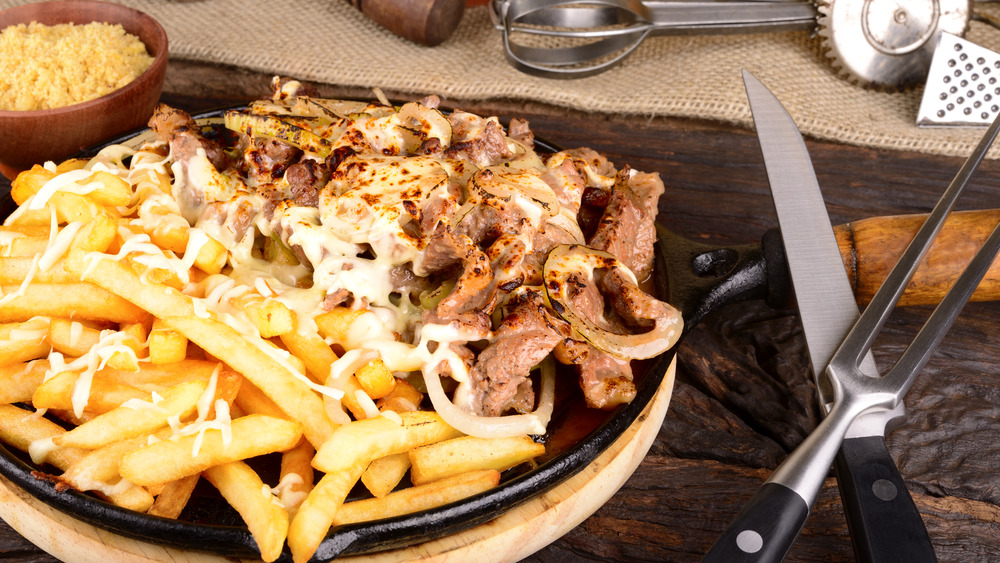8 Things To Eat And 7 Not To Eat At A Brazilian Steakhouse
What are the best things to eat at a Brazilian steakhouse? That can be a tough order to tackle, as the classic rodizio-style restaurant with gauchos bringing endless sticks of meat to your table can be a little overwhelming. And if trying to pick between picanha, filet mignon, bacon-wrapped scallops, and flank steak weren't enough, there's also a massive salad bar. Plus enough carbs on your table to fuel a marathon runner.
With so many choices, sometimes it's equally as important to know what NOT to eat too. After all, eating at a Brazilian steakhouse isn't cheap, and unless you're related to Andre the Giant and/or a 15-year-old boy, you've only got so much room in your stomach. So, we consulted with a chef and some notable experts in Brazilian steakhouse dining world, and got their advice on the best ways to spend your calories. From farofa to filet mignon here's what to eat –- and what not to eat –- at a Brazilian steakhouse.
Picanha in the ultimate Brazilian steakhouse dish
"When anyone thinks of a Brazilian steakhouse, the first thing they think of is picanha," says Jean Delgado, the executive chef at Toro Toro in Miami. If you're not overly familiar with picanha, it's the crescent shaped cut with the fat cap that's become the iconic image of rodizio, and the quintessential cut to get when you go. According to Steak School, the cut is taken from the cow's backside, also called the rump cap, rump cover, sirloin cap, or occasionally culotte. But the Brazilian Steakhouse preparation, with a hint of salt, is called picanha (pronounced PEEK-hahn-ya).
Chef Delgado told Mashed that picanha is best served medium rare to medium, to ensure the fat and juices are all captured in the meat. He added it's especially important to make sure that picanha is sliced correctly as well. It should be cut against the grain, to ensure the proper texture. Otherwise it can be unpleasantly chewy, and ruin the overall experience.
Bacon-wrapped scallops are another must-have at a Brazilian steakhouse
The other quintessential Brazilian steakhouse menu item isn't even steak, according to Jean Delgado, Executive Chef at Toro Toro in Miami; it's seafood wrapped in pork. The traditional skewers of bacon-wrapped scallops start with fresh sea scallops, then put a thick coating of cured bacon around them, and are roasted in the rodizio until the bacon is delightfully crispy. The smoke flavor from the cured meat and the grill, along with the bacon fat, seeps into the savory scallops, creating a unique flavor that's hard to find elsewhere. "People love this classic dish," says Chef Delgado. "The mom and pops wanna go back just for the bacon wrapped scallops."
They're not the only seafood item that's worth checking out at a Brazilian steakhouse, though. James Hills, author of the food and travel blog Mantripping, who wrote this extensive guide to Brazilian steakhouses, told Mashed if you see salmon or lobster on the rodizio to give it a shot. "If you see something that's new or different," he says, "don't let it be limited to beef."
Brazilian steakhouse chorizo and brisket sausage are winners
As you settle in for your festival of meat at a Brazilian steakhouse, you may see your servers gliding around holding long metal skewers of sausage. Many times, this will be Brazilian chorizo, a cured-meat sausage that's especially tasty out of the rodizio. According to HuffPost, the Brazilian version is very similar to the original Spanish chorizo, which includes sweet and hot varieties of pork mixed with paprika. "If there's one item I love [at a Brazilian steakhouse] it's chorizo," says Jean Delgado, Executive Chef at Toro Toro in Miami. "I think it's because they rotate it in with their steaks, it's just a great quality."
In addition to the chorizo, Delgado also recommends trying the Brazilian brisket sausages, if they're being offered. He told Mashed the finely ground brisket is mixed with paprika and garlic that don't overpower the meat. And when it's smoked it creates a flavor profile unique to this sausage.
Brazilian steakhouse beef ribs are as good to look at as they are to eat
When beef ribs come out at a Brazilian steakhouse, it's a little reminiscent of Fred Flintstone getting a slab of brontosaurus meat that's so big it topples his car. James Hills, author of the food and travel blog Mantripping, described the visual of beef ribs brought to the table as a sight that's just as impressive to the eyes as it is to the stomach. "Pork ribs, they're nice, but it's mostly bone," he told Mashed. "Beef ribs coming out on a plate, it's just this giant hunk of meat that's big and juicy and fatty. It's a cool experience."
The flavor, Hills said, is equally monumental, with perfectly caramelized edges on the meat giving the ribs a hint of sweetness. Hills added that despite the massive size, beef ribs served rodizio style give you a chance to try them without filling yourself up. "At a regular steakhouse, by the time you get through [a beef rib] it's a lot of fat and heaviness," he explained. "But just a piece of it, it's perfect."
Brazilian steakhouse lombo -- or pork loin -- is a parmesan-crusted treat
Though beef tends to be the star attraction at a Brazilian steakhouse, it's far from the only thing on the menu. And in addition to stuffing yourself with enough beef to feed a pre-school class, part of the idea in going is also to try some stuff that's unique to Brazilian cuisine. In its guide to eating at Brazilian steakhouses, Fly & Dine suggests branching out from the stuff you know, and delving into some other specialties. Among those is the traditional Brazilian pork loin known as lombo.
Fly & Dine describes it as a parmesan-crusted cut, and promises "you'll be rewarded for your adventure." Grill Hall, a churrascaria in Maple Grove, Minnesota, delves a little deeper into lombo, describing at as a "traditional, slow-roasted, style of pork is usually seasoned sparingly with salt, garlic, and some other herbs." With the pork fat constantly rolling over the cut as it spins in the rodizio, it locks in juices and the smoky flavor. It's not exclusively served with a parmesan crust — sometimes it's covered with other cheeses, or sometimes none at all. But parmesan is the most common.
If you're going for a side at a Brazilian steakhouse, go for farofa
The abundance of side dishes at a Brazilian steakhouse can be conflicting; you're spending a lot of money to enjoy the beef, so using valuable stomach space on sides might seem like a waste. At the same time, you also want to try some classic Brazilian dishes that don't come on a stick. Mantripping's James Hills told Mashed that even if you're there for meat, it's worth trying a side or two, and if you've got to try one, he says it's farofa. "Personally, I don't love it, but it's a fun way to explore another culture," he shared.
Farofa, according to Rio and Learn, is a toasted yucca flour that's prepared all kinds of ways; typically served as a side with meat, rice, or beans, but you may see it served by itself too. Additionally, another common preparation is feijoada, where fojada is mixed with sausage, bacon, and vegetables. Brazilian steakhouse chain Fogo de Chao offers it as part of its menu, and though feijoada will fill you up more, it's also quite the culinary adventure.
Wash it down at a Brazilian steakhouse with agua fresca or a caipirinha
Though red wine and juicy steak are as natural a pairing as Diet Coke and Biscoff cookies (just trust us), you may be well served to resist the temptation to imbibe in the juice. While most Brazilian steakhouses will have a pretty solid wine list, Mantripping suggests instead pairing your meat with something more unique to the cuisine. Its guide to Brazilian steakhouses points to the caipirinha — a traditional cocktail of cachaca, sugar, and lime ––as a refreshing, zesty drink that contrasts with the salty, greasy flavors of the steak perfectly.
If you're not trying to include alcohol in your meal, you're not limited to tap water and fountain sodas either. Mantripping suggests trying guarana soda, a Brazilian specialty with a fruity flavor that has the added bonus of guarana to keep you out of a meat-induced food coma. Another non-alcoholic option: agua fresca. This is a simple mixture of blended fruit with water and sugar that's definitely on the sweet side, but gives you lots of booze-free ways to complement your meal.
Don't go nuts at the salad bar at a Brazilian steakhouse
If there is one universal piece of advice about eating at a Brazilian steakhouse, it's not to fill up at the salad bar. To wit: in Zagat's video guide explaining everything people do wrong at a Brazilian steakhouse, before even discussing the steak, Churrascaria Plataforma meat carver Sandro Lorenzi tells everyone not to overdo it at the buffet. "A common mistake people make here is going crazy at the salad bar," he says of his New York restaurant. "They don't save room for the meat."
Mantripping's James Hills agreed when talking to Mashed, with a caveat that vegetarians or those not looking to gorge can save some money by dining solely at what Brazilian steakhouses refer to as the Market or Harvest Table. But if you're spending $60 a person to enjoy steak, don't get your fill at the salad bar. "Have a little of that stuff, olives, or charcuterie, to cut the fat from the steaks," Hills advised. "But don't fill up on salad if you're there for steak."
Don't eat the meat at a Brazilian steakhouse without adding sauces
In a traditional steakhouse, drowning your prime filet in steak sauce is a big-time no-no. It might even earn you a not-so-subtle sneer from your waiter if you try, and will definitely infuriate the chef. But this's not the case at a Brazilian steakhouse — not because the meat is of inferior quality, but because according to Jean Delgado, Executive Chef at Toro Toro in Miami, it's not very seasoned. "You don't see much seasoning," he told Mashed, "so it's kind of bland."
This, however, is easily offset by the abundance of sauces most Brazilian steakhouses offer on the side. Typically, this will include yucca flour and a vinaigrette sauce called molho a campanha – that's a little like a pico de gallo with red and green peppers instead of tomatoes. According to Insider, the acidic side is meant to cut the fat and complement the meat in the main course, and you're welcome to cover your meat in a little or as much of it as you want. "There is no wrong way to do the toppings," meat carver Sandro Lorenzi told Zagat. "Just do as you like it."
Don't gorge on the first meats that come to your table at a Brazilian steakhouse
As you saunter up to a Brazilian steakhouse, there's a decent chance you starved yourself all day, so as to be completely ravenous by the time dinner rolls around. Or, at the very least, you could make the most of your investment. And if you've managed to heed our earlier advice and not immediately squelch that hunger at the salad bar, you may be temped to pile your plate with the first meats that show up at your table. But while satisfying, this may not be the best idea.
In its guide to eating at Brazilian steakhouses, Groupon stresses some patience after you flip your card to green. Steakhouses, the online coupon site says, often back load the more expensive and tastier cuts of meat, so the juicy picanha and prime rib won't show up until after the flank steak and chicken; if you can hold off a little bit you'll get the better stuff. Though when skewer after skewer of delicious meat is wafting by your nose, we know this can be much easier said than done.
There's no need to eat chicken at a Brazilian steakhouse
Yes, if you're watching your cholesterol, a chicken breast is often a wiser choice than a big hunk of fatty steak. But if you're watching your cholesterol, why'd you just drop $75 on an all-you-can-eat steak dinner? Opting for the healthier option went out the window the minute you booked a table at a Brazilian steakhouse, and though the chicken may well be tasty and finely-prepared, Mantripping's James Hills says it's kind of a waste. "I'm reluctant to say 'in general,' because everyone is a little different, but if you look at the selections that are out, some are not as prime as others," he revealed to Mashed. "So I never get chicken; chicken is not what I'm going to spend my appetite budget on."
Hills also says the same typically goes for pork, although the lombo can be a worthwhile venture into Brazilian cuisine if you're up for it. Bottom line: Realize what you came to a Brazilian steakhouse to eat, and don't fill up on the other stuff.
Believe it or not, filet mignon isn't the best idea at a Brazilian steakhouse
Filet mignon is often held up as the ultimate cut of steak, a tender, expensive variety that's used interchangeably with caviar and champagne in luxe life hyperbole. According to the Robb Report, this is mostly because the muscle it comes from — the tenderloin in the lower back — is especially tender because it isn't used much. "They're not doing gymnastics," Katie Flannery, butcher and COO at Flannery Beef, told Robb Report, "So filet muscle get almost zero use during the animal's lifetime. That's why it's so tender."
While this might seem an inviting reason to stop the gaucho when he comes by with a skewer full of filet, it's not always the best way to spend your stomach space. Fly & Dine points out that while filets — which are low in fat — are great as 6 oz. or 8 oz. cuts, little pieces of it wrapped in bacon really won't do much for you. And Brazilian cuts like picanha, which are designed to be served rodizio style, are likely the better move.
Ribeye is also better left on the skewer at a Brazilian steakhouse
Again, advising against ribeye is not to say that Brazilian steakhouses use lesser-quality cuts of meat than their American counterparts. In fact, in an interview with Fly & Dine, Henrique Hoeppel Huyer, head gaucho at Fogo de Chao in Los Angeles, divulged that the chain uses only 100 percent Black Angus beef, and that Fogo is highly selective about the cuts they pick. "You need naturally tender beef," he said, so stuff like chuck and round typically don't end up in the rodizio.
And ribeye, especially higher-quality ribeye, still scores well in the tenderness department, and is far higher in fat and flavor than filet mignon, according to Robb Report. But at the end of the day it's still an American cut, and ultimately something you'll find in abundance elsewhere. Much like with filet mignon, Fly & Dine recommends skipping it and saving room for picanha and frandinha, both cuts that are more Brazilian specialties.
Take it easy on the carby, starchy sides at a Brazilian steakhouse
The parade of side dishes that come out when you flip your card to green at a Brazilian steakhouse are a carb lover's dream. To that end, watching this Zagat video can really get your stomach rumbling; as soon as the diner announces she's ready for steak, the waiter gracefully arrives bearing French fries, rice, mashed potatoes, yucca flour, fried polenta, black beans, fried bananas, and broccoli and carrots — so you can pretend you're doing something healthy. Those alone could make a meal, and the starch-inclined among us might be tempted to pile our plates. But it's not the best idea.
Fly & Dine appropriately calls them "a distraction," and while the site stops short of saying you shouldn't indulge in the pao de queijo (cheese puffs that also often accompany the sides), it does suggest limiting your sides consumption to about 20 percent of your total intake. The sides are much cheaper, yet still more filling than the steaks circling your table, and therefore a far less efficient use of your money and appetite.
